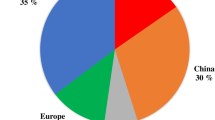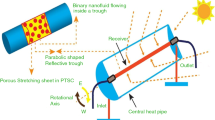Abstract
The proposed study aims to test the thermo-electrical, and exergy efficiency of a hybrid PVT collector cooled by pure water, copper (Cu)/water, and aluminum-oxide (Al2O3)/water nanofluids, respectively. A model is mathematically constructed using the energy-balance equation across all the layers of the hybrid PVT collector. For the validation of the proposed mathematical model, the outcomes of the proposed numerical model are compared with the experimental data of the literature. The impact of volume fraction (vol%) and mass flow rate (m) of the nanofluids on the PVT outcomes has been analyzed and demonstrated. The study displays a better PVT performance with Cu/water nanofluid compared to Al2O3/water nanofluid and pure water. Merely a 2% volume concentration of Cu nanoparticles results in a 4.98% and 5.23% improvement in the average electrical and thermal efficiencies, respectively. At a mass flow rate of 0.03 kg/s, the thermo-electrical efficiency of the PVT with Cu/water nanofluid improve by 4.45% and 2.9%, respectively, concerning the pure water. Further, the impact of several tubes and their diameter is also investigated on the thermo-electrical efficiencies of the hybrid PVT collector. The tube diameter has not any substantial effect on the performance, whereas the thermo-electrical performance significantly enhanced with the rise in the number of tubes.
Graphic abstract


















Similar content being viewed by others
References
Kasaeian A, Fatemeh R, Yan W-M (2019) Osmotic desalination by solar energy: a critical review. Renew Energy 134:1473–1490
Kasaeian A, Rahdan P, Vaziri MAR, Yan W-M (2019) Optimal design and technical analysis of a grid-connected hybrid photovoltaic/diesel/biogas under different economic conditions: a case study. Energy Convers Manag 198:111810
Diwania S, Siddiqui AS, Agrawal S, Kumar R (2020) Performance assessment of PVT-air collector with V-Groove absorber: a theoretical and experimental analysis. Heat Mass Transf. https://doi.org/10.1007/s00231-020-02980-0
Shahsavar A, Ameri M (2010) Experimental investigation and modeling of a direct-coupled PV/T air collector. Sol Energy 84:1938–1958
Huang B, Lin T, Hung W, Sun F (2001) Performance evaluation of solar photovoltaic/ thermal systems. Sol Energy 70:443–448
Mojumder JC, Chong WT, Ong HC, Leong KY, Abdullah-Al-Mamoon. (2016) An experimental investigation on performance analysis of air type photovoltaic thermal collector system integrated with cooling fins design. Energy Build 130:272–285
Kabeel AE, Hamed MH, Omara ZM, Kandeal AW (2018) Influence of fin height on the performance of a glazed and bladed entrance single-pass solar air heater. Sol Energy 162:410–419
Kamthania D, Nayak S, Tiwari GN (2011) Performance evaluation of a hybrid photovoltaic thermal double pass facade for space heating. Energy Build 43:2274–2281
Diwania S, Agrawal S, Siddiqui AS, Singh S (2019) Photovoltaic-thermal (PV/T) technology: a comprehensive review on application and its advancement. Int J Energy Environ Eng 11:33–54
Brideau SA, Collins MR (2012) Experimental model validation of a hybrid PV/thermal air-based collector with impinging jets. Energy Procedia 30:44–54
Sopian K, Yigit KS, Liu HT et al (2000) Performance of a double pass photovoltaic thermal solar collector suitable for solar drying systems. Energy Convers Manag 41(4):353–365
Herrando M, Markides CN, Hellgardt K (2014) A UK-based assessment of hybrid PV and solar-thermal systems for domestic heating and power: system performance. Appl Energy 122:288–309
Prakash J (1994) Transient analysis of a photovoltaic–thermal solar collector for co-generation of electricity and hot air/water. Energy Convers Manage 35(11):967–972
Bergene T, Lovvik OM (1995) Model calculations on a flat plate solar heat collector with integrated solar cells. Sol Energy 55(6):453–462
Guarracino I, Mellor A, Ekins-Daukes NJ, Markides CN (2016) Dynamic coupled thermal and electrical modelling of sheet-and-tube hybrid photovoltaic/thermal (PVT) collectors. Appl Therm Eng 101:778–795
Akhavan-Behabadi MA, Hekmatipour F, Mirhabibi SM et al (2015) Experimental investigation of thermal–rheological properties and heat transfer behavior of the heat transfer oil–copper oxide (HTO–CuO) nanofluid in smooth tubes. Exp Therm Fluid Sci 68:681–688
Javadi FS, Saidur R, Kamalisarvestani M (2013) Investigating performance improvement of solar collectors by using nanofluids. Renew Sustain Energy Rev 28:232–245
Sardarabadi M, Passandideh-Fard M, Heris SZ (2014) Experimental investigation of the effects of silica/water nanofluid on PV/T (photovoltaic thermal units). Energy 66:264–272
Yazdanifard F, Ameri M, Ebrahimania-Bajestan E (2017) Performance of nanofluid-based photovoltaic/thermal systems. RSER 76:323–352
Sardarabadi M, Passandideh-Fard M (2016) Experimental and numerical study of metal-oxides/ water nanofluids as coolant in photovoltaic thermal systems (PVT). Sol Energy Mater Sol Cells 157:533–542
Khanjari Y, Pourfayaz F, Kasaeian A (2016) Numerical investigation on using of nanofluid in a water-cooled photovoltaic thermal system. Energy Convers Manag 122:263–278
Rejeb O, Sardarabadi M, Ménézo C, Passandideh-Fard M, Dhaou MH, Jemni A (2016) Numerical and model validation of uncovered nanofluid sheet and tube type photovoltaic thermal solar system. Energy Convers Manag 110:367–377
Naghdbishi A, Yazdi ME, Akbari G (2020) Experimental investigation of the effect of multi-wall carbon nanotube-water glycol based nanofluids on a PVT system integrated with PCM covered collector. Appl Therm Eng 178:115556
Xu Z, Kleinstreuer C (2014) Concentration photovoltaic–thermal energy co-generation system using nanofluids for cooling and heating. Energy Convers Manag 87:504–512
Xu Z, Kleinstreuer C (2014) Computational analysis of nanofluid cooling of high concentration photovoltaic cells. J Therm Sci Eng Appl 6:031009
Fayaz H, Nasrin R, Rahim NA, Hasanuzzaman M (2018) Energy and exergy analysis of the PVT system: Effect of nanofluid flow rate. Sol Energy 169:217–230
Aberoumand S, Ghamari S, Shabani B (2018) Energy and exergy analysis of a photovoltaic/thermal system using nanofluids: an experimental study. Sol Energy 165:167–177
Hissouf M, Feddaoui M, Nazim C, A. (2020) Numerical study of a covered Photovoltaic-Thermal (PVT) enhancement using nanofluids. Sol Energy 199:115–127
Tang LQ, Zhu QZ (2014) Performance study of flowing-over PV/T system with different working fluid. Appl Mech Mater 488:1173–1176
Cui Y, Zhu Q (2012) Study of photovoltaic/thermal systems with MgO–water nanofluids flowing over silicon solar cells. In: 2012 Asia-Pacific power and energy engineering conference. IEEE, pp 1–4
Nasrin R, Rahim NA, Fayaz H, Hasanuzzaman M (2018) Water/MWCNT nanofluid based cooling system of PVT: experimental and numerical research. Renew Energy 121:286–300
Chow T (2003) Performance analysis of photovoltaic-thermal collector by explicit dynamic model. Sol Energy 75:143–152
Xuan Y, Li Q (2003) Investigation on convective heat transfer and flow features of nanofluids. J Heat Transf 125:151–155
Pak BC, Cho YI (1998) Hydrodynamic and heat transfer study of dispersed fluids with submicron metallic oxide particles. Exp Heat Transf Int J 11:151–170
Jia Y, Ran F, Zhu C, Fang G (2020) Numerical analysis of photovoltaic-thermal collector using nanofluid as a coolant. Sol Energy 196:625–636
Rajaee F, Rad MAV, Kasaeian A, Mahian O, Yan WM (2020) Experimental analysis of a photovoltaic/thermoelectric generator using cobalt oxide nanofluid and phase change material for heat sink. Energy Convers Manag 212:112780
Bhattarai S, Oh JH, Euh SH, Krishna Kafle G, Hyun Kim D (2012) Simulation and model validation of sheet and tube type photovoltaic thermal solar system and conventional solar collecting system in transient states. Sol Energy Mater Sol Cells 103:184–193
Acknowledgements
The authors would like to thank Dr. Haroon Ashfaq, Associate Professor, Electrical Engineering Department, Jamia Millia Islamia, New Delhi, for his kind support in the research work. The authors also thank the Department of Electrical and Electronics Engineering Krishna Institute of Engineering and Technology Ghaziabad for providing the necessary laboratory facilities for the research work.
Author information
Authors and Affiliations
Corresponding author
Ethics declarations
Conflict of interest
The authors declare that they have no conflict of interest.
Additional information
Technical Editor: Jader Barbosa Jr.
Publisher's Note
Springer Nature remains neutral with regard to jurisdictional claims in published maps and institutional affiliations.
This article has been selected for a Topical Issue of this journal on Nanoparticles and Passive-Enhancement Methods in Energy.
Appendix
Appendix
The heat transfer coefficients (HTCs) used in Eqs. (1–3)
where δ, λ are the depth of the particular layer and thermal conductivity, respectively. Dout is the outer tube diameter.
The heat transfer coefficients (HTCs) used in Eq. (4)
The heat transfer coefficients (HTCs) used in Eq. (5)
where hnf is the convective HTC represents the forced flow of nanofluid circulating in the tubes.
The heat transfer coefficients (HTCs) used in Eq. (6)
The constant used in Eq. (8)
The constant A and B used to simply Eq. (10)
The Pe, Re and Pr denotes the Peclet, Reynold and Prandtl numbers
The thermophysical properties of base fluid used in mathematical modeling
Rights and permissions
About this article
Cite this article
Diwania, S., Siddiqui, A.S., Agrawal, S. et al. Modeling and assessment of the thermo-electrical performance of a photovoltaic-thermal (PVT) system using different nanofluids. J Braz. Soc. Mech. Sci. Eng. 43, 190 (2021). https://doi.org/10.1007/s40430-021-02909-6
Received:
Accepted:
Published:
DOI: https://doi.org/10.1007/s40430-021-02909-6




